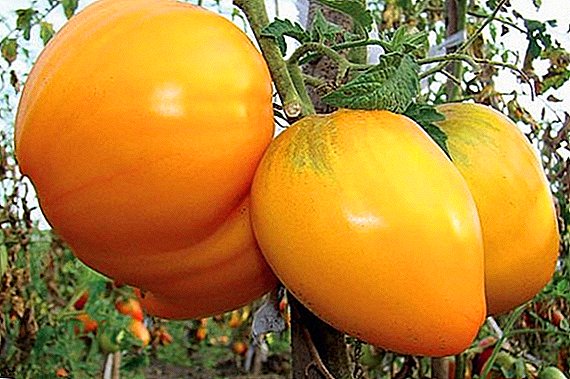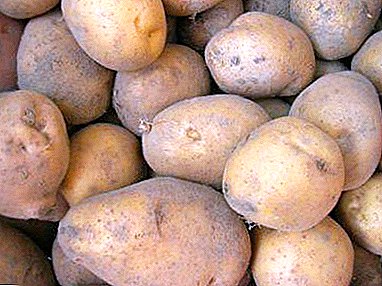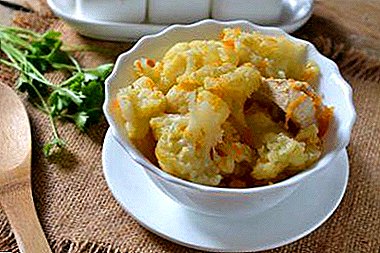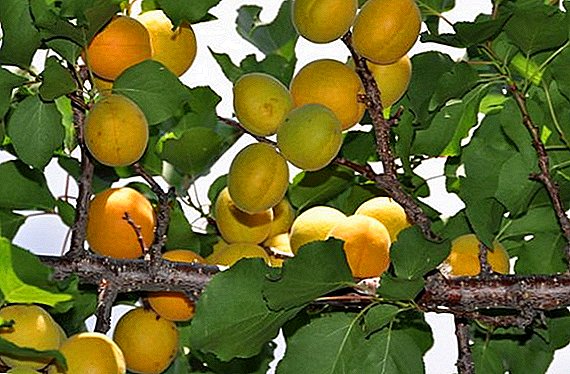 Manchurian Apricot is a picturesque tree that can be a decoration and pride of an orchard in your backyard. These trees look beautiful in the form of hedges along fences or forest belts. During the flowering apricots are covered with amazingly beautiful pink haze of large fragrant flowers. About the peculiarities of growing at home this ornamental tree with edible fruits will be discussed in the article.
Manchurian Apricot is a picturesque tree that can be a decoration and pride of an orchard in your backyard. These trees look beautiful in the form of hedges along fences or forest belts. During the flowering apricots are covered with amazingly beautiful pink haze of large fragrant flowers. About the peculiarities of growing at home this ornamental tree with edible fruits will be discussed in the article.
Botanical description
Abrikos Manchurian, in Latin - Prúnus mandschúrica, belongs to the genus Slivovyh. This tree is up to 15 meters in height, with filigree foliage and lush crown, throwing out a lot of shoots. The bark is dark gray, cracked by deep furrows.  Flowers pink, more than 2 cm in size, on branches are arranged in groups or singly, on short pedicels. The tree blooms profusely, every spring from April-May, about 12 days.
Flowers pink, more than 2 cm in size, on branches are arranged in groups or singly, on short pedicels. The tree blooms profusely, every spring from April-May, about 12 days.
Leaves grow up to 12 cm, have a wide oval, biconicular shape, pointed tops.
Fruits are small, up to 2.5 cm in diameter, yellowish-orange, velvety pubescent. Ripening time - from the end of July. A tree that easily can live for more than 100 years easily grows from a fruit seed.
You will be interested to know about the features of cultivation of such varieties of apricots as "Triumph", "Red Cheek", "Black Velvet", "Black Prince", "Kuban Black", "Prince March", "Zherdela", "Peach".
Distribution and ecology
Manchurian apricot is a rare Red Book plant. It grows in China in the northeastern provinces, in the north of Korea, as well as in the vast southern territory of Primorsky Krai in Russia.  This tree is able to tolerate both drought and low temperatures. He likes a fair amount of light, but is not demanding on soils: it can grow even on dry mountain slopes.
This tree is able to tolerate both drought and low temperatures. He likes a fair amount of light, but is not demanding on soils: it can grow even on dry mountain slopes.
Manchurian apricot has a large and extensive root system, so it is good to plant it along reservoirs to strengthen the coastline, as well as the slopes, to protect them from landslides.
Did you know? Manchurian apricots got their name in the XVIII-XIX centuries from the area in northeastern China - Manchuria, where they were widely distributed. Later, when these trees from China hit the European territory of Russia, the name preserved behind them.
Application in landscape design
When planting these decorative fruit trees on your plot, you will need to decide on their purpose: these will be trees in the form of a hedge, a single planting or a whole garden.
You will be the winner in any case: these trees from April to October will decorate the compound and please the eye with a riot of colors. 
- Since the flowers of this tree are of a delicate pink color and more than 2 cm in size, these are the very first spring honey plants, spreading their honey aroma far beyond the gardens.
- When the fruiting period comes, among the bright greens of the openwork foliage, small golden fruit-lanterns will shine.
- In the autumn, the leaves will become a blood-red hue and will burn on the tree until the first frost, highlighting the empty garden with its radiance.
If this spreading tree is used as a tapeworm in landscape design, it will attract all the attention and dominate against the background of the facade of the building, gazebos or decorative fencing.
In green construction, apricot trees of this variety are well planted along with other trees. They are perfectly combined with the Manchurian birch, Mongolian oak, juniper and spruce, Amur linden, dimorphant and other trees and shrubs. 
Did you know? The Europeans did not know about apricots until Alexander the Great had brought them to Greece from the East. They came to the Greeks to taste and soon spread throughout Europe.
Tree fruits
The first harvest of fruits from apricot trees can be waited in 5-7 years after planting. They begin to ripen in late July or early August.
Apricots have a flat-oval shape, yellowish, with orange splashes. They taste not very juicy, more acidic than southern varieties, and give a bitter taste. Because of such taste, not everyone likes to eat them in their natural form.
But they make fragrant jams, preserves and compotes.
Learn how to make jam, preserves and apricot compote for the winter, as well as how to dry and freeze properly.Each individual fruit weighs up to 20 grams.

Growing at home
In order to grow such beautiful trees on your farmstead, you need to follow some general recommendations. Below we will talk about the nuances of growing Manchurian apricot.
Features of planting and breeding
The most suitable time for planting Manchurian apricot is the end of April. Due to a sufficient number of sunny days, the soil warms up well and persistent frosts do not threaten. The main landing requirement is to do this before the fruit buds begin to swell.
If you purchased seedlings in the autumn, you should take them more seriously. During the winter frosts, the fragile root system can be damaged, so be sure to mulch the soil around the trunk. What means to use - let's talk about it below.  When planting, it is imperative to make sure that the seedlings are provided with good air drainage, due to which in the spring the trees will be better heated by the sun. To do this, you need to carefully consider which place is best for them.
When planting, it is imperative to make sure that the seedlings are provided with good air drainage, due to which in the spring the trees will be better heated by the sun. To do this, you need to carefully consider which place is best for them.
Having decided on a place for landing, you need to prepare a landing hole. The optimal size is 70 cm deep and the same in width. For spring planting such a pit is prepared in the autumn and is filled with compost, the composition of which will be described below.
Important! The greatest yield of apricot Manchu provides planting groups in groups with other varieties, as it allows cross-pollination of flowers. If the size of the site does not allow this, then grafting is done on one tree with branches of other varieties.
When planting, the presence of two people is desirable: one of them should hold the tree behind the headquarters, and the other at this time will sprinkle it with earth, compacting it around the roots. After planting, it is necessary to water the saplings with enough water and cover with mulch.  There are two ways to grow this wonderful tree in your garden: from a stone and grafting. Below we give a detailed description of these methods.
There are two ways to grow this wonderful tree in your garden: from a stone and grafting. Below we give a detailed description of these methods.
From bones
There are some features in planting an apricot seedling tree. Planting them in the fall, you can expect a different germination result: from 0 to 90%. This planting material can be stored in the soil, maintaining its germination for years, and can abruptly wake up in any season, even if it is not suitable for the growing season.
Check out the features of growing apricots from the stone.
In order to act for sure and get the maximum result, it is better to plant the plant just before the winter cold, otherwise, during the autumn thaws, the seeds planted before this period can rise early and die at the very first frost. By the way, this can happen in the spring.
First of all, you need to fill in the water selected for planting the bones and remove all the surfaced - so there will be a culling of poor quality material.  Then, quality seeds should be planted at a depth of about 1 cm, not allowing the root collar of the seedling to be under the ground and rot.
Then, quality seeds should be planted at a depth of about 1 cm, not allowing the root collar of the seedling to be under the ground and rot.
Before planting, it would also be good to carry out a 3-month stratification: hold the bones in a cold room or refrigerator at a temperature of about 0 ° C, having previously placed them in a container with wet sand, without covering it. Such freezing will additionally provide them with good germination.
Important! Manchurian apricot can grow on any type of soil. However, if the site has close groundwater, the tree needs good drainage. For this, a layer of crushed stone with a thickness of 30 cm is suitable.
After planting and germination of the seedlings, careful care is needed: they should be watered, loosened around the soil, removed weeds and mulched. At the end of the two-year period, young trees are ready to transplant to a permanent place.
Planting apricot pits
Cuttings
For reproduction of Manchurian apricot, cuttings must be prepared in late June - early July, and planted in the last decade of September.
To prepare the future planting material, you need to cut a cutting with two or three internodes, on which a couple of leaves grow, from the most powerful and sturdy branches of the parent tree.
From above, the stalk is cut perpendicular to the growth of the trunk, about 1 cm above the bud, and from below the cut is made beveled. The cuttings prepared in this way are placed in a vessel with a liquid growth stimulator and brought into a warm room (at a temperature not lower than 24 ° C) for 15 hours.
It is very important to consider the level of water in the tanks with cuttings. So that the roots are actively formed, you need a sufficient amount of oxygen, because they are formed in the place of the cutting, where the boundary of air and water passes.  If the tank is deep and filled with water more than necessary - it means that there will be little oxygen below, and this will lead to rotting of the planting material.
If the tank is deep and filled with water more than necessary - it means that there will be little oxygen below, and this will lead to rotting of the planting material.
Place of planting need to prepare in advance. To do this, you need to make a small rut of the desired length, depth up to half a meter and a width of 85-90 cm. Lay out the bottom of the rut with broken brick and sprinkle it with river sand on top. The height of this layer should be up to 5 cm.
Read the tips on the care and planting of apricot, about the features of autumn and spring planting.
The next layer in the track will be a soil mixture consisting of sand, soil, manure and wood ash (1: 3: 1: 1.5). Next, you need to evenly distribute the mixture on the bottom of the track, compact and moisten with a weak solution of potassium permanganate.
Planted seedlings in such a way that the base of each of them only slightly touched the layer of soil mixture at the bottom of the track. To do this, one person holds the sapling at the desired height, the other - he falls asleep with the same soil mixture to the level under the upper bud with leaves.  To hide the seedlings from sudden changes in temperature, a small wooden structure is installed over each of them and they are wrapped around it with a film on all sides.
To hide the seedlings from sudden changes in temperature, a small wooden structure is installed over each of them and they are wrapped around it with a film on all sides.
Soil and fertilizer
If you plan to immediately plant seedlings at the place of their permanent growth, you need to prepare the landing hole in the fall.
It is filled with humus, consisting of one or two buckets of mullein with the addition of one glass of wood ash, 400 g of potassium sulphate and 700 g of granulated superphosphate. Upon the arrival of spring, the pit is cleared of humus, and in it you can already plant an apricot seedling.
As soon as the first signs of growth are noticed, it is necessary to make dressing from water and manure for cuttings: take 6 parts of water for 1 part of manure and allow to stand for 7 days. Feeding trees is best done during watering. 
Important! In the spring, when the snow melts, apricot stands need potash and phosphate fertilization, and in the period of abundant fruiting the need for nitrogen increases.
Watering and moisture
After planting seedlings and wrapping them in greenhouses, you need to provide them with further proper care. It consists in creating an optimally moist environment for the trees: it is the spraying of the cuttings themselves, and not of the earth around them, until they start to grow actively.
Although Manchurian apricot is also drought-resistant, it needs regular watering during transplantation and vigorous growth. This is especially true of such months as May and June. After the tree needs watering only during a drought, which happens in July - early August.
Irrigation rates are calculated as follows: at least 1 liter of water is needed for 1 square meter of stalked soil. During dry weather, the rate should be doubled.  It is important to remember that it is impossible to over-water the saplings in August, since the growth of the shoots can be delayed and they may not mature to the beginning of winter, as a result of which they will freeze.
It is important to remember that it is impossible to over-water the saplings in August, since the growth of the shoots can be delayed and they may not mature to the beginning of winter, as a result of which they will freeze.
Loosening and mulching
In the second or third year after planting an apricot tree, it is necessary not only to water it regularly and feed it in the summer, but also to loosen the soil under it, and also to mulch the tree trunk.
When it rains, the soil is usually crusted, so it needs to be loosened periodically. This should be done not only for aeration, but also to keep it clean. It is impossible to dig up the soil, as this can damage the roots of the plant.
Mulching is done with sawdust, peat, straw or grass.
At the end of the fourth year after planting, it is better not to mulch the trees, since this is fraught with the formation of surface roots, which in the subsequent winter period can freeze.  It is better to sow lawn grass under a tree, which must sometimes be mowed. Thus, soil quality will also improve.
It is better to sow lawn grass under a tree, which must sometimes be mowed. Thus, soil quality will also improve.
For the winter, peat chips or sawdust can be used to mulch the soil. This will warm the roots and save the sapling from frost. As soon as the first stable layer of snow falls, it must be carefully tamped around the tree.
Important! If the Manchurian tree loses moisture, it helps to reduce the size of the fruit in the current season, as well as reducing the formation of flowering ovaries and low yields for the next year.
Preparing for the winter
Although Manchurian apricots are known for their winter hardiness, they still need preparation for the cold. You need to start cooking trees in August. In order for the wood on the shoots to ripen well, it is necessary to feed seedlings with phosphorus-potash fertilizers. As already mentioned, watering is reduced during this period.  We have already described how to insulate the root system for the winter. However, the root neck of the tree also needs warming, because in this case it is not so much the cold and the cold that is how much temperature drops.
We have already described how to insulate the root system for the winter. However, the root neck of the tree also needs warming, because in this case it is not so much the cold and the cold that is how much temperature drops.
This can lead to the formation of a frost on the neck, which will not allow access of oxygen to the roots, and the tree may subsequently weaken and die.
Therefore, a protective layer of mulch should be at least 20 cm in height, and the trunk itself should be wound with agrofiber or spunbond (industrial insulators) from the root to the first twigs.
If the complexion of apricot trees is fully integrated, this can guarantee their protection even from excessively low temperatures.  It is also recommended to wrap the trunks of wintering apricots with roofing felt to protect against rodents. Wrap the barrel with this material should not be tight, leaving an air cushion. Top ruberoid can be wrapped with agrofiber. This will provide additional insulation and support air circulation.
It is also recommended to wrap the trunks of wintering apricots with roofing felt to protect against rodents. Wrap the barrel with this material should not be tight, leaving an air cushion. Top ruberoid can be wrapped with agrofiber. This will provide additional insulation and support air circulation.
You can also build a small greenhouse above each tree. To do this, you need to wrap the seedling with any heat-insulating material, then install 4 pegs around it and wrap with plastic wrap.
Pests and diseases
Most of all, Manchu apricots are affected by fungal diseases. This usually occurs during frequent and heavy summer-spring rains. Due to the high humidity of the leaves and fruits can develop klyasterosporioz, verticillis, moniliosis.
Learn how to deal with pests and diseases of apricots.To avoid this, apricot trees should be regularly pruned and sprayed with fungicides, and whitewashed trunks and skeletal branches.
 Another enemy of apricot trees is plum aphid. This pest lays black testicles in the autumn, placing them at the base of the kidneys, which belong to one-year shoots.
Another enemy of apricot trees is plum aphid. This pest lays black testicles in the autumn, placing them at the base of the kidneys, which belong to one-year shoots.In early spring, when the first leaflets appear, the larvae appear from the testicles. They begin to feed on the tissue juices of the leaf, attaching to its underside. Also, the aphids prefer juices of tender shoots of the plant.
Although the leaves of apricot, affected by aphids, do not curl, they still gradually dry out.
To avoid damage to trees by this pest, it is necessary even before the budding of the buds, and then during the period of their disclosure in the spring, spraying with the insecticidal drug "Decis" or its equivalent.  Due to its positive characteristics and qualities, Manchurian apricot can take the main place in the green construction of your garden.
Due to its positive characteristics and qualities, Manchurian apricot can take the main place in the green construction of your garden.
By caring for these trees throughout the year, you will receive pleasant emotions and a bountiful harvest of fruits, from which excellent jams, compotes and jelly are obtained. In addition, you will contribute to the spread of rare and useful plants.












